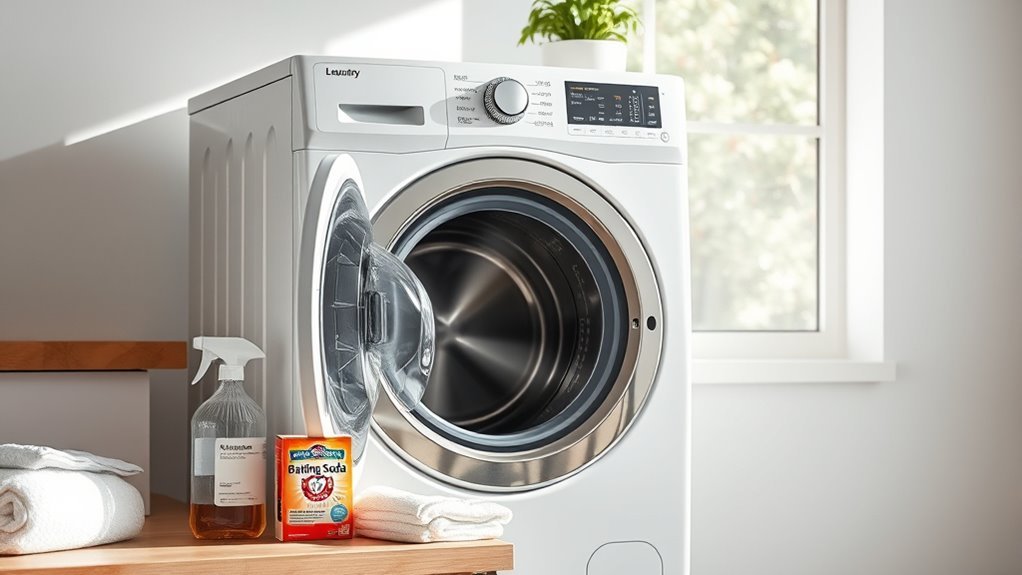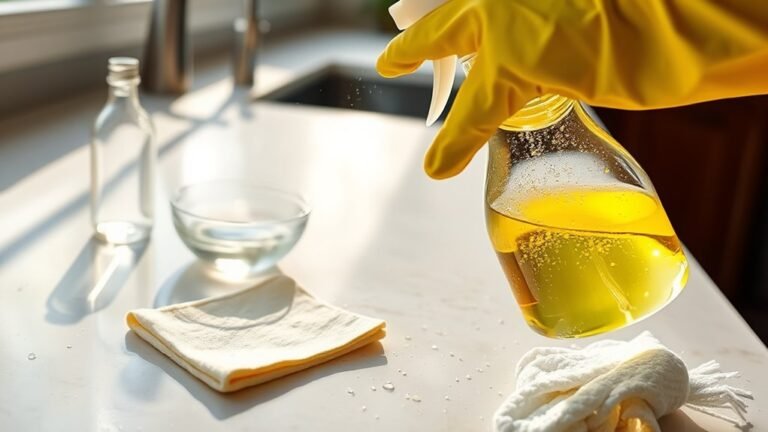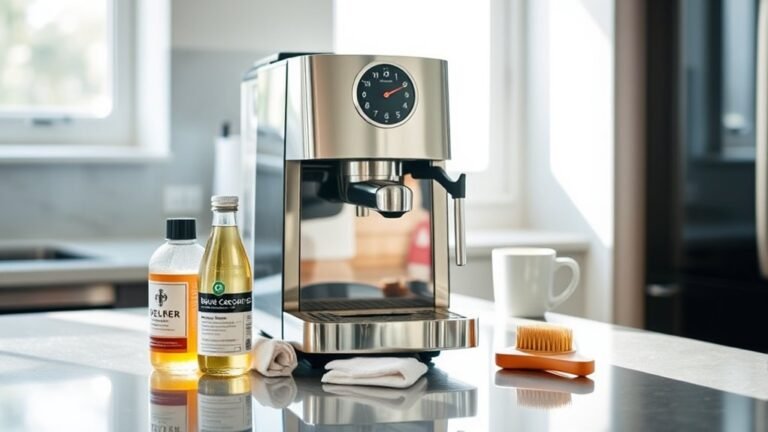How to Clean and Maintain Your Washing Machine
To clean and maintain your washing machine, start by gathering supplies like vinegar, baking soda, and a microfiber cloth. Remove and soak the detergent drawer, then scrub the rubber door seal to prevent mold. Run a hot water cleaning cycle with vinegar or a cleaner to freshen the drum. Don’t forget to clean the filter and check hoses for wear or leaks regularly. Leave the door open after use to let it dry. Keep these habits up, and you’ll discover even more tips to keep your machine in top shape.
Gather the Necessary Cleaning Supplies
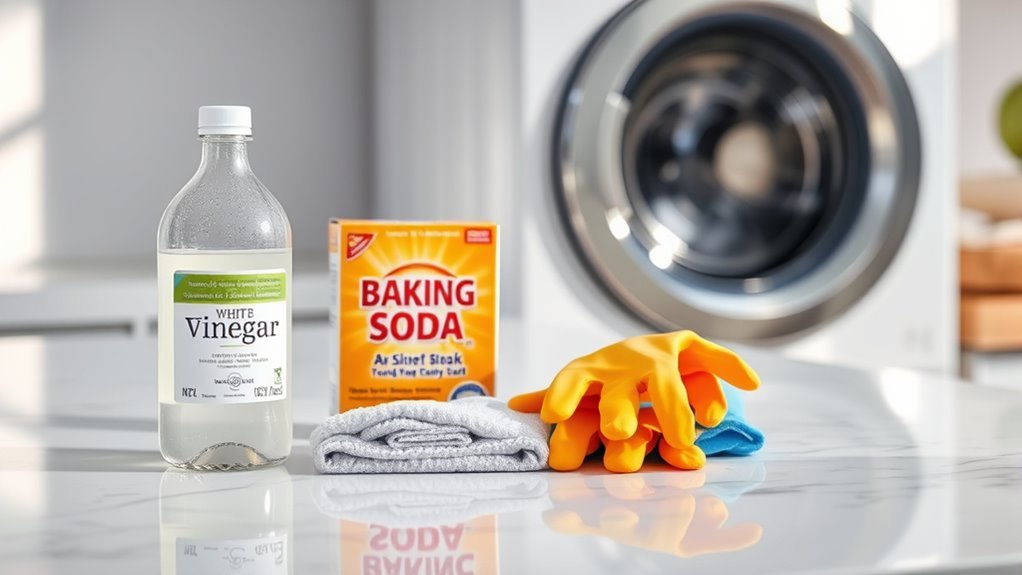
Before you begin cleaning your washing machine, you’ll need to gather a few essential supplies. Having the right cleaning tools on hand lets you work efficiently and enjoy the freedom of a fresh, well-maintained appliance. Essential supplies include white vinegar, baking soda, a microfiber cloth, an old toothbrush, and a bucket. These simple items tackle grime, mold, and residue without harsh chemicals. You might also want rubber gloves to protect your hands while scrubbing. By preparing these cleaning tools beforehand, you avoid interruptions and make the process smoother. With everything ready, you’ll quickly regain control over your washing machine’s cleanliness, freeing you from worries about odors or buildup. Gathering the right supplies is your first step toward hassle-free maintenance.
Clean the Detergent Dispenser Drawer
The detergent dispenser drawer often collects soap residue and mildew, which can affect your washing machine’s performance and cause unpleasant odors. Taking control of dispenser maintenance frees you from these nuisances and keeps your machine running smoothly. To tackle detergent buildup effectively:
Regular cleaning of the detergent dispenser prevents residue and mildew, ensuring optimal washing machine performance and freshness.
- Remove the dispenser drawer carefully from the machine.
- Soak it in warm water mixed with mild detergent for 15 minutes.
- Use a soft brush to scrub away trapped detergent buildup and mildew.
- Rinse thoroughly and dry before reinserting it.
Run a Hot Water Cleaning Cycle
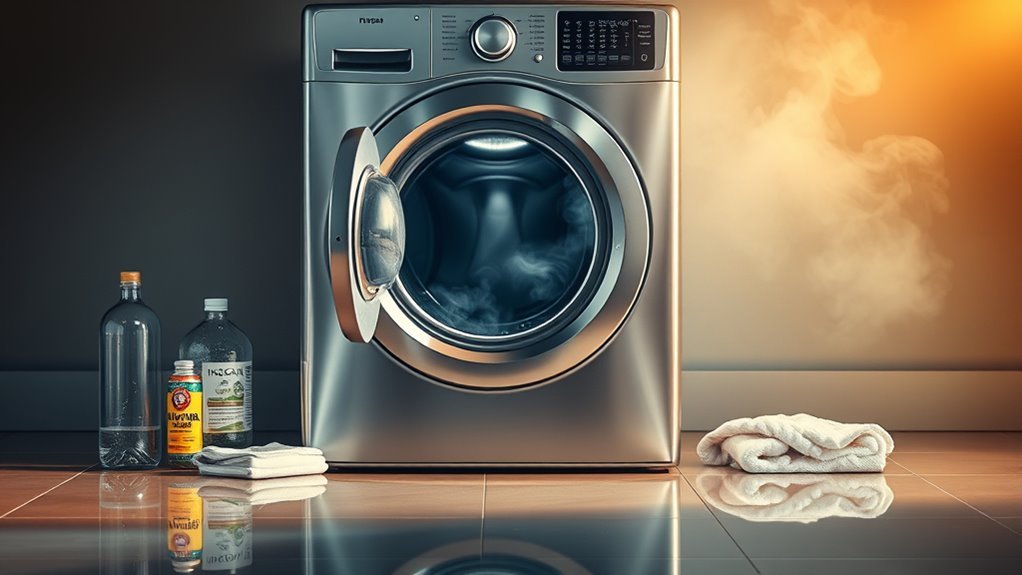
To keep your washing machine fresh, you’ll want to run a hot water cleaning cycle regularly. Select the hottest water setting and add a washing machine cleaner or a cup of white vinegar to help break down buildup. Aim to do this once a month to maintain peak performance and hygiene.
Selecting Hot Water Settings
Selecting the right hot water setting is key to effectively cleaning your washing machine. Hot water benefits your machine by loosening grime and killing bacteria that cold water can’t tackle. To enjoy the freedom of a fresh, clean washer, follow these temperature guidelines:
- Use the hottest setting your washer allows without damaging fabrics.
- Aim for temperatures around 130°F to 140°F for ideal cleaning.
- Avoid excessively high temperatures that could harm rubber seals or hoses.
- Always check your machine’s manual to find the recommended hot water range.
Adding Cleaning Agents
One effective way to keep your washing machine fresh is by adding the right cleaning agents before running a hot water cycle. You don’t have to rely solely on harsh chemicals; natural alternatives like white vinegar, baking soda, or lemon juice work wonders. These natural cleaning agents break down residue and eliminate odors without harming your machine or the environment. Simply pour about two cups of white vinegar or half a cup of baking soda into the detergent dispenser, then start the hot water cycle. This frees you from buildup and keeps your washer running smoothly. Choosing natural alternatives also gives you the freedom to maintain your machine healthily and sustainably, aligning with your desire for a cleaner, eco-friendly lifestyle.
Cycle Frequency Recommendations
After adding natural cleaning agents like vinegar or baking soda, you’ll want to know how often to run a hot water cleaning cycle to keep your machine in top shape. The right cycle timing depends on your machine usage and lifestyle. Here’s a quick guide:
- If you use your washer daily, run a hot water cleaning cycle once a week.
- For moderate usage (a few times per week), aim for every two weeks.
- Light users can clean monthly to avoid buildup.
- Always adjust if you notice odors or residue sooner.
Regular hot water cycles free you from lingering grime, helping your machine run efficiently and your laundry stay fresh. Embrace this simple routine to maintain freedom from unexpected breakdowns or foul smells!
Remove and Clean the Rubber Door Seal
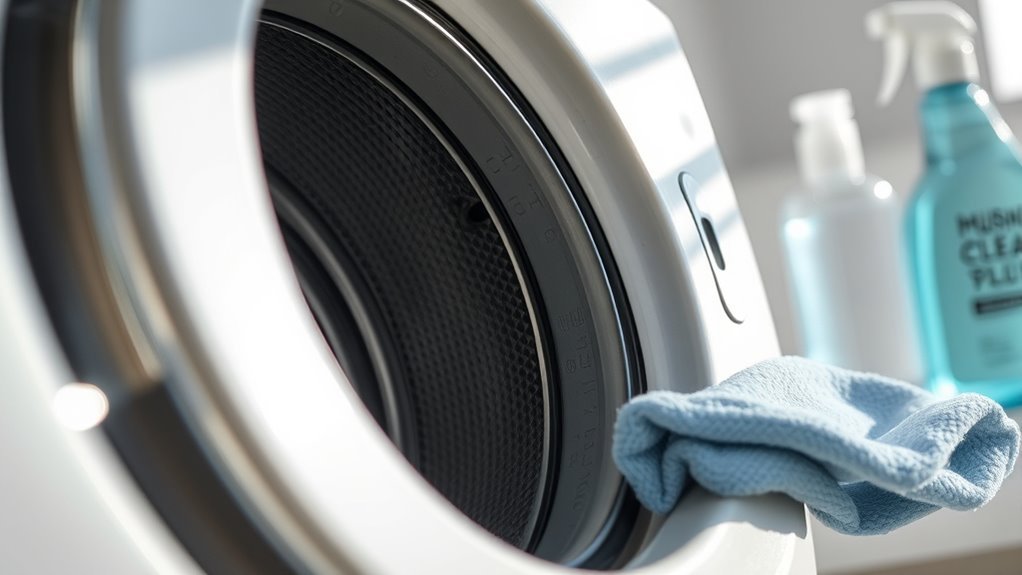
Now’s a good time to check the rubber door seal for any mold buildup, which can cause odors and damage. You’ll want to carefully remove and clean it using a mixture of water and mild detergent or vinegar. Make sure to dry it thoroughly to prevent mold from returning.
Inspect for Mold Growth
Because the rubber door seal is a common spot for mold to develop, you should inspect it regularly to prevent unpleasant odors and potential damage. Taking control of mold prevention not only keeps your machine fresh but also safeguards your health from risks associated with mold exposure. Here’s how you can stay ahead:
- Peel back the seal gently to check for hidden mold patches.
- Look for black or green spots, which indicate mold growth.
- Sniff for musty odors that signal mold presence.
- Act promptly if you find mold to keep your freedom from health hazards intact.
Proper Cleaning Techniques
While inspecting the rubber door seal is essential, you’ll also need to remove and clean it thoroughly to eliminate mold and grime buildup. Start by gently pulling back the seal to expose hidden dirt, then wipe it down with a mixture of equal parts water and white vinegar. Avoid harsh chemicals—they often fall under cleaning myths that can damage your machine. Taking these preventive measures regularly keeps mold away and extends your washer’s life. After cleaning, leave the door open to let the seal dry completely. This simple step frees you from lingering odors and moisture problems. Remember, maintaining your washing machine isn’t about complicated routines but smart, consistent care that empowers you with freedom from frequent repairs.
Clean the Washing Machine Drum
Before you start cleaning the drum, make sure the washing machine is empty and unplugged for safety. Drum cleaning is essential for your machine’s longevity and your freedom from funky odors and buildup. Follow these maintenance tips for a fresh, efficient wash:
Always unplug and empty your washer before cleaning to ensure safety and keep your machine fresh and odor-free.
- Pour two cups of white vinegar into the drum to break down residue.
- Run a hot water cycle to dissolve grime and kill bacteria.
- Sprinkle half a cup of baking soda inside the drum and run a short hot cycle to neutralize odors.
- Wipe the drum and door seal with a clean cloth to remove any leftover dirt.
Regular drum cleaning keeps your washer running smoothly, giving you the freedom to enjoy fresh laundry without hassle.
Check and Clean the Filter
If you want your washing machine to work efficiently, checking and cleaning the filter regularly is a must. The filter traps lint, hair, and small debris that can clog your machine and affect performance. Start by locating the filter—usually near the bottom front behind a small panel. Remove it carefully and rinse under running water to clear any buildup. Filter maintenance tips include cleaning it every month and inspecting for damage.
Keep an eye out for filter replacement signs like cracks, persistent blockages, or water drainage issues. Addressing these promptly guarantees your washer runs smoothly and prevents costly repairs. Taking charge of your machine’s filter frees you from unexpected breakdowns and keeps laundry day hassle-free.
Inspect and Maintain Hoses
Once you’ve kept the filter clean, the hoses are the next part of your washing machine that need regular attention. Proper hose inspection can prevent leaks and water damage, giving you peace of mind and freedom from unexpected repairs. Here’s how to maintain them:
- Check hoses for cracks, bulges, or leaks every few months.
- Feel for weak spots by gently squeezing the hoses.
- Replace any hose showing signs of wear immediately—don’t wait for a failure.
- Use high-quality, reinforced hoses for longer durability and safety.
Regular hose replacement every 3 to 5 years guarantees reliability and keeps your machine running smoothly. Taking these simple steps means you’re in control, free from worry, and can enjoy your washing machine without hassle.
Leave the Door Open to Dry
Though it might seem minor, leaving the washing machine door open after each use is key to preventing mold and unpleasant odors. This simple habit improves humidity control inside your machine, letting moisture evaporate freely. By doing this, you avoid a stuffy, trapped environment where bacteria thrive. Just guarantee door safety by keeping the open door clear of obstacles to prevent accidents. Enjoy the freedom of a fresh-smelling laundry room without constant worry.
| Benefit | Emotion | Result |
|---|---|---|
| Fresh air flow | Relief | No mold, no smell |
| Humidity control | Confidence | Longer machine life |
| Door safety | Peace of mind | Safe space, no accidents |
| Simple habit | Empowerment | Easy upkeep, more freedom |
Schedule Regular Maintenance Checks
Regular maintenance checks every few months can save you from costly repairs and extend your washing machine’s lifespan. Staying on top of a maintenance checklist helps you avoid unexpected breakdowns and keeps your freedom intact—no more unplanned laundry disruptions. Use seasonal reminders to schedule these checks, making it effortless to keep your machine in peak shape. Here’s a simple list to guide you:
- Inspect hoses and connections for leaks or cracks.
- Clean detergent dispensers and filters to prevent clogs.
- Run a cleaning cycle with washing machine cleaner or vinegar.
- Check the drum and door seals for mold or debris buildup.
Frequently Asked Questions
Can I Use Bleach Instead of Vinegar for Cleaning?
You can use bleach instead of vinegar, but you should weigh the cleaning effectiveness and safety. Bleach is a strong cleaner and disinfectant, but it can be harsh on your machine and the environment. If you’re seeking freedom from harsh chemicals, consider bleach alternatives like baking soda or specialized washing machine cleaners. These options still offer good cleaning effectiveness without the risks bleach might bring, helping you maintain your machine safely and freely.
How Often Should I Replace My Washing Machine?
You’ll want to keep an eye on your washing machine’s replacement schedule to avoid unexpected breakdowns. Typically, they last about 10-15 years, but signs of aging like unusual noises, leaks, or poor cleaning performance mean it’s time to reflect on a new one. Don’t feel chained to an old machine—upgrading can free you from constant repairs and give you more reliable, efficient laundry days ahead.
Is It Safe to Use Fabric Softener With All Washing Machines?
You’ll want to check your washing machine compatibility before using fabric softener because not all machines handle it well, especially high-efficiency models. If you’re aiming for freedom from potential buildup or damage, consider fabric softener alternatives like wool dryer balls or vinegar. These options keep your clothes soft without risking your machine’s performance. Always read your machine’s manual to make sure you’re choosing what’s safest and most effective for your setup.
Can Washing Machines Clean Themselves Without Detergent?
Imagine your washing machine like a trusty car—sometimes it needs more than just a quick rinse to run smoothly. Some machines have self-cleaning features that help keep grime at bay, but they often work best with detergent alternatives like vinegar or baking soda. While they can clean themselves to a degree, skipping detergent entirely might leave buildup behind. So, embracing these natural options lets you maintain freedom from harsh chemicals without sacrificing cleanliness.
What Are Signs My Washing Machine Needs Professional Repair?
If you’re hearing unusual noises like grinding or banging, it’s a strong sign your washing machine needs professional repair. Don’t ignore persistent error codes flashing on the display either—they’re your machine’s way of asking for help. When your washer starts acting up and limits your freedom to do laundry easily, it’s best to call a pro. Fixing problems early keeps you moving and avoids bigger headaches down the road.
